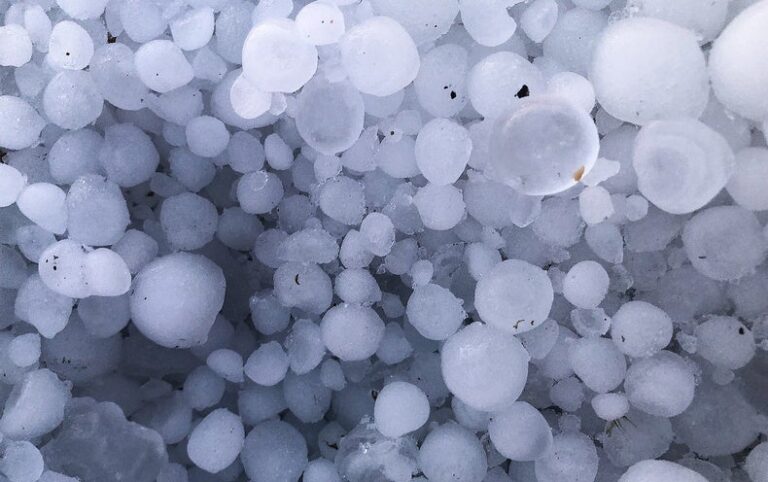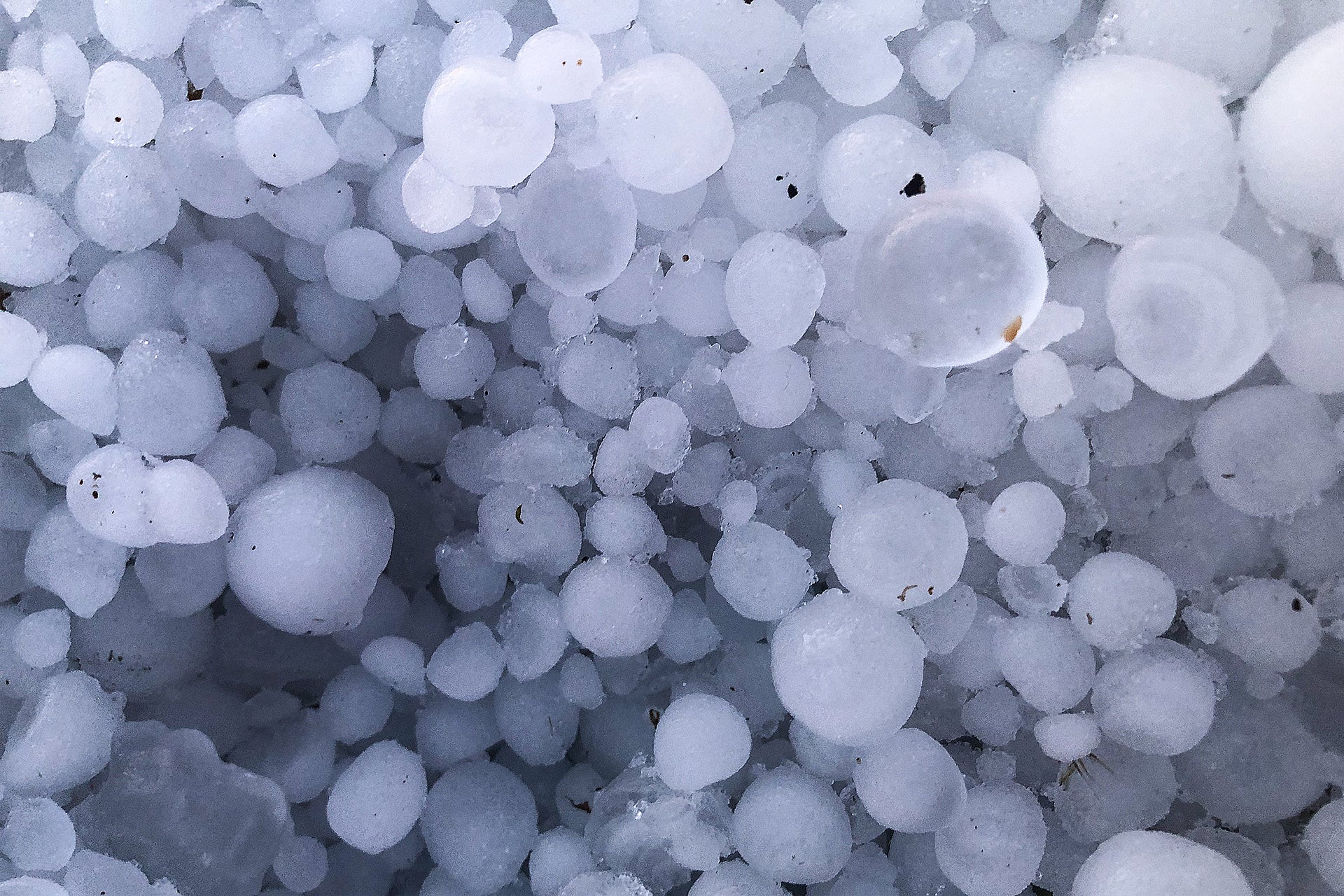
[ad_1]

Just five days after a 6.2-inch (16-centimeter) hailstone fell in Italy and set a new European record, another ball of ice with a diameter of 7.6 inches (19.46 cm)—more than twice the size of a softball—dropped from stormy skies over the country and broke the record again.
This second hailstone also approached the world record, which was set in South Dakota in 2010 by a hailstone eight inches (20.3 cm) in diameter—almost as large as a bowling ball—according to the National Weather Service. It’s easy to assume less ice would be falling from the sky in a warming world, but the connection isn’t quite that simple. Experts say some areas will likely see an increase in hailstorms, along with more potentially damaging hail, even as the global surface warms.
“Ten years ago the narrative was we would have less hailstorms under a changing climate,” says Katja Friedrich, an atmospheric scientist at the University of Colorado Boulder. “And that’s not what we see, actually, even though the temperatures are going up.”
That’s because there are other climate change effects that might make hail more likely. Hail-producing thunderstorms have three ingredients, Friedrich says: strong updrafts (warm, rising air that fuels the storm); an unstable atmosphere (which happens when there is a cold, dry air layer over a warm, wet one); and abundant atmospheric moisture.
Warmer air holds more moisture, and warming near Earth’s surface contributes to atmospheric instability, which can promote more storms. Climate change can also fuel strong updrafts, says Victor Gensini, who researches severe convective storms and climate change at Northern Illinois University. “If you think of updraft in the storm as a hot-air balloon, if you create more hot air, it just rises faster,” Gensini says.
Updrafts are crucial to the formation of hailstones, which start as tiny ice particles that researchers call embryos. An updraft lofts these particles into regions of a storm several miles above the ground, where liquid water is present at temperatures below freezing. This supercooled water has gotten cold so quickly that it hasn’t had time to crystallize into ice, but it’s chilled and primed to stick to any passing hail embryo. The embryos grow into soft ice pellets called graupel, says Sonia Lasher-Trapp, an atmospheric scientist at the University of Illinois at Urbana-Champaign. If the updrafts are strong enough and last long enough, the graupel can keep growing and become denser. Eventually, though, the updrafts can no longer support the weight of the ice, and it falls to the ground as hail. The dynamics of this process can be very complex, Lasher-Trapp says—which is why forecasters can usually warn people that hail-producing storms are likely but can’t typically predict exactly where hail might fall or what size it might be. “It’s almost like studying the end of a food chain,” Lasher-Trapp says. “There are so many factors that go into hail, so that makes it a big challenge to predict.”
Many storms produce hailstones that never hit the ground; they’re small enough that they melt as they fall through warmer air near the planet’s surface. But large enough hailstones can strike at a deadly velocity. A baseball-sized hunk of hail falls at 100 miles per hour (161 kilometers per hour), says Harold Brooks, a senior research scientist at the National Oceanic and Atmospheric Administration’s National Severe Storms Laboratory.
The largest hail, Brooks says, falls in the Pampas in northern and central Argentina and in the Great Plains of the U.S. In both cases, geography is to blame. The Great Plains have a ready source of surface-level moisture from the Gulf of Mexico, and the Pampas get moisture from the Amazon rain forest. Higher, dryer air for storms comes from over the Rocky Mountains and the Andes, respectively; as air travels over these mountain ranges, it rises, cools and dries out. Brooks says Italy’s Po Valley is also known as a hail region, where storms are fed when winds blow over the Alps from the northwest and hit warmer, wetter air masses from the Adriatic Sea.
Predicting whether the Po Valley—or any other region—will have more monster-sized hail in the future is currently impossible because extreme hail is such a rare event, Brooks says. Still, there is some evidence that north-central Italy is seeing more hailstones in the two- to three-inch (five- to 7.5-cm) range, he says, as are the northern Great Plains of the U.S.
But climate change may stymie hail in more southerly latitudes, such as Texas. This is both because warmer air melts hailstones before they hit the ground and because severe storms may have a harder time getting started in these warmer regions. When surface temperatures are higher, the distance the warm air must rise to reach colder layers above also rises. This can stop a storm before it starts, Brooks says.
In other words, it’s a balancing act. And knowing exactly where and when that balance might tip is doubly tricky. First, hail observations are inconsistent. (If a giant hailstone falls on an uninhabited part of the prairie in Kansas, does it make a world record?) This limits the data available to scientists. Second, there are still many aspects of hail-formation dynamics that researchers don’t understand. “Once you get down to the updrafts and the downdrafts in a storm like that, you’re actually pushing up against the numerical fidelity of models,” or how accurately a computer can simulate reality, says Richard Rood, an emeritus professor of climate and energy at the University of Michigan.
Storm researchers are looking to fill in these blanks, though. A large, multi-institutional effort called the In-situ Collaborative Experiment for the Collection of Hail in the Plains (ICECHIP) is currently submitting a proposal to the National Science Foundation to do field observations of hailstones across the Great Plains. There hasn’t been a large systematic field study of hail since the early 1970s, says Gensini, who is a co-principal investigator on the project. (The University of Colorado Boulder’s Friedrich is also involved.) A better grasp on the basics of hail formation would not only improve daily forecasting but would also feed into climate research on the future of hailstorms, he says.
“The exciting part about hail,” Gensini says, “is that we are very much in the infancy of our understanding.”
[ad_2]